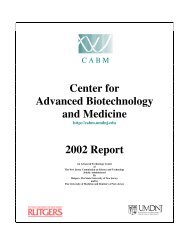Annual Report 2011 - Center for Advanced Biotechnology and ...
Annual Report 2011 - Center for Advanced Biotechnology and ...
Annual Report 2011 - Center for Advanced Biotechnology and ...
Create successful ePaper yourself
Turn your PDF publications into a flip-book with our unique Google optimized e-Paper software.
mRNA interferases<br />
mRNA interferases are encoded by one of the TA systems. MazF from E. coli is<br />
the first mRNA interferase discovered in Dr. Inouye’s laboratory <strong>and</strong> functions as<br />
a sequence-specific (ACA) endoribonuclease. Its induction in E. coli cells results<br />
in growth arrest <strong>and</strong> eventual cell death. The Inouye group also observed that<br />
MazF induction in mammalian cells effectively causes Bak (a pro-apoptotic<br />
protein)-dependent programmed cell death. The application of bacterial mRNA<br />
interferases <strong>for</strong> mammalian cell growth regulation is currently being explored to<br />
develop an effective, novel method <strong>for</strong> cancer treatment <strong>and</strong> HIV eradication. In<br />
addition to E. coli MazF, the laboratory has identified a large number of mRNA<br />
interferases having different RNA cleavage specificity, including one from a<br />
highly halophilic archaeon that cleaves a specific seven base sequence. mRNA<br />
interference using highly sequence-specific mRNA interferases instead of<br />
antisense RNA or RNAi may be a novel <strong>and</strong> exciting way to regulate gene<br />
expression.<br />
Single protein production in living cells<br />
Expression of MazF, an ACA-specific mRNA interferase, results in nearly<br />
complete degradation of cellular mRNAs, leading to almost complete inhibition<br />
of protein synthesis. Intriguingly, MazF-induced cells are still fully capable of<br />
producing a protein at a high level if the mRNA <strong>for</strong> that protein is engineered to<br />
have no ACA sequences without altering its amino acid sequence. There<strong>for</strong>e, it is<br />
possible to convert E. coli cells into a bioreactor producing a single protein of<br />
interest. This “single-protein production” (SPP) system allows NMR structural<br />
studies of proteins without purification, which makes this system especially useful<br />
<strong>for</strong> structural studies of membrane proteins. In addition, the SPP system provides<br />
a unique opportunity to produce proteins in which all the residues of a specific<br />
amino acid in a protein are replaced with toxic non-natural amino acid analogues<br />
to create proteins of novel structures <strong>and</strong> functions.<br />
Publications:<br />
Awano, N., Rajagopal, V., Arbing, M., Patel, S., Hunt, J., Inouye, M., Phadtare, S.<br />
Escherichia coli RNase R has dual activities, helicase <strong>and</strong> ribonuclease. J.<br />
Bacteriol. 2010 192(5):1344-52.<br />
Peng, Y.Y., Yoshizumi, A., Danon, S.J., Glattauer, V., Prokopenko, O.,<br />
Mirochinitchenko, O., Yu, Z., Inouye, M., Werkmeister, J.A., Brodsky, B.,<br />
Ramshaw, J.A. A Streptococcus pyogenes derived collagen-like protein as a noncytotoxic<br />
<strong>and</strong> non-immunogenic cross-linkable biomaterial. Biomaterials 2010<br />
31(10):2755-61.<br />
Jung-Ho Park<br />
Graduate Student<br />
Narumi Tokunaga<br />
Graduate Student<br />
Zhuoxin Yu<br />
Graduate Student<br />
Dr. Qian Tan<br />
Research Teaching Spec.<br />
Chun Ying Xu<br />
Research Teaching Spec.<br />
Dr. Yoshihiro<br />
Yamaguchi<br />
Research Teaching Spec.<br />
Dr. Yong Long Zhang<br />
Research Teaching Spec.<br />
Xushen Chen<br />
Lab Technician<br />
16



